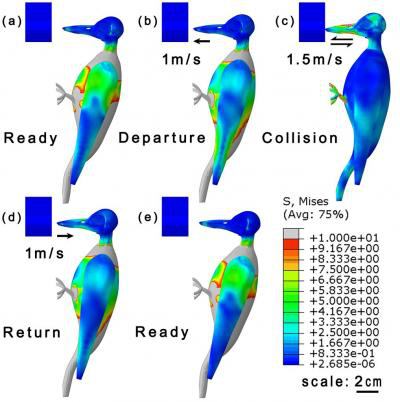Woodpecker's head checked for shock response
Researchers are looking at how woodpeckers manage to avoid injury as they engage in high-velocity impacts with trees.
Designing devices to protect the body from shock and vibrations is an ongoing challenge, and engineers are now studying the unique morphology of the woodpecker to find out how its body functions as such an excellent anti-shock structure.
 The woodpecker is a model of near perfection in anti-shock capability.
The woodpecker is a model of near perfection in anti-shock capability.
It can peck trees at high frequency (up to 25 pecks per second) and high speed (around 7 m/s with 1200g deceleration) without suffering any brain injury.
Some element of its shape and form allows it to absorb incredible impact energy, and Chinese scientists may have the keys to its anti-shock biomechanical structure.
A team at China’s State Key Lab of Structural Analysis for Industrial Equipment has used computed tomography and the construction of high-precision three-dimensional models of the woodpecker to look at its energy distribution and conversion abilities.
To build a sophisticated 3D model of the woodpecker, researchers took CT scans of its structure and replicated it in remarkable detail.
“Based on the CT scanning technology... detailed inner structure images of the head were obtained and then imported to Mimics software to form a scattered-points model,” the research papers state.
The woodpecker's structure was recreated through intricate geometric modeling.

“The final FE [finite element] model has 940,000 fine elements with a minimum size of 0.07 mm in the head, 70,000 coarse elements with a maximum size of 3.5 mm in the body and 20,000 elements with a minimum size of 0.16 mm in the trunk,” the researchers state.
The team then used the 3D models to test how impact energies were handled by its specially-adapted structure.
The results revealed that the body not only supports the woodpecker to peck on the tree, but also stores the majority of the impact energy in the form of strain energy, greatly reducing the quantity of impact energy that enters the brain.
“Most of the impact energy in the pecking is converted into the strain energy stored in the body (99.7%) and there is only a small fraction of it in the head (0.3%),” the researchers reported.
“High-speed impacts and collisions can destroy structures and materials,” scientist Wu Chengwei states.
“In the aerospace industry, spacecraft face the constant danger of collisions with space debris and micrometeoroids.
“If a spacecraft's structure or scientific instruments were destroyed by impact, the economic loss would be huge.”








 Print
Print